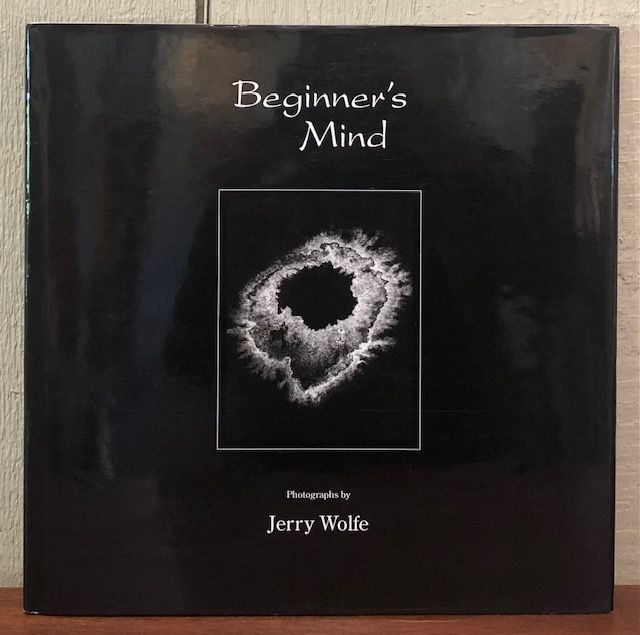Every once in a while, one runs across a work that is so powerfully moving, so visionary, that it is as though the spiritual cosmos itself has briefly transformed into (or, with a wink to itself, escaped into) corporeal existence; the artist that serves as channel for this wondrous interpenetration of spirit and matter can only be described as an Uber-artist, or more simply, an Uber genius. Allow me to introduce you to a candidate for such an honor...
"...Humanity owes its progress to geniuses...[but] humanity is not want to deal kindly with its geniuses..." (Stanislaw Lem, "Odysseus of Ithaca", Non Servium)
In the April 2007 issue of the fine-art
B&W photography magazine (issue #50), I ran across the work of photographer Jerry Wolfe, the front cover of whose extraordinary book -
Beginner's Mind - is reproduced at the top of this Blog entry; and was awe-struck by the intensity of spiritual depth captured, and radiated, by his mesmerizing images. The last image of the published series, in particular, titled
Cave Detail (page 99, B&W issue #50), triggered a spiritual odyssey - in
me - with echoes of visions my youthful self had of what was possible with photography (when in the right eyes and hands) when I first glanced at Minor White's visionary
Capitol Reef.
"...First come your run-of-the-mill and middling geniuses, that is of the third order, whose minds are unable to go much beyond the horizon of their times. These, relatively speaking, are threatened the least; they are often recognized and even come into money and fame..." (Stanislaw Lem, "Odysseus of Ithaca", Non Servium)
Mr. Wolfe has been a photographer for over 30 years, gracefully combining his preturnaturally gifted eye for beauty with his lifelong spiritual practice of mindfulness and Buddhist meditation. All of his images are subtlety charged with a quiet grace; as though they are earthly imprints of a mysterious, ethereal spiritual grammar. Their meaning shifts, even as you observe them; and observe them you will, for while, objectively speaking, they are (as are all prints) nothing more than "flat, two-dimensional worlds", they reveal worlds - and worlds of meaning - far beyond the limitations of the page they live on, and sometimes point to even vaster, more mysterious worlds within.
"...The geniuses of the second order are already too difficult for their contemporaries and therefore fare worse...recognition awaits the geniuses of the second order, in the form of a triumph beyond the grave..." (Stanislaw Lem, "Odysseus of Ithaca", Non Servium)
Mr. Wolfe's Beginner's Mind is an extraordinary work of art, with an emphasis on extra-ordinary, for it transcends even (otherwise conventionally) symbolic levels of meaning, achieving visual/spiritual tones rarely attained by even the most "gifted" of artists. How does he do this? I have no idea, nor could I, except to embrace the idea that all of us are humble channels for nature's own creative powers.
"...The intermediate types [beyond second but below first order] are discovered either by the succeeding generation or by some later one..." (Stanislaw Lem, "Odysseus of Ithaca", Non Servium)
Condider just one small part of Mr. Wolfe's Opus, his Buddhist Expressions Series (#1 - #12, pages 20-43 in Beginner's Mind), which Mr. Wolfe (humbly, poetically and very appropriately) opens with ...
Each Moment
Fresh and original.
Where's the "I"
Experiencing this?
To which, after seeing these wondrous prints, I can only say that they are among the finest abstracts I have ever seen. Not because they are merely "beautiful abstracts" (which they surely are), but because they embody the core Kandinsky-like essence of what a true "abstract" represents: a portal to other, higher, worlds and realities.
"...the geniuses of the first order are never known - not by anyone, not in life, not after death. For they are creators of truth so unprecedented, purveyors of proposals so revolutionary, that not a soul is capable of making head or tail of them..." (Stanislaw Lem, "Odysseus of Ithaca", Non Servium)
Mr. Wolfe is certainly not threatened by obscurity, for he is already a well known artist, teacher and author. But he represents a small class of profoundly gifted visionaries that - for whatever reason (perhaps simply the vagaries of life's currents) - are not much better known than they are!
I urge all fine-art photographers, particularly those with a penchant for using their art for spiritual exploration, to experience Mr. Wolfe's
Beginner's Mind for themselves (you can also order it from
Amazon).
Who knows what paths a simple click of a mouse might take you?











